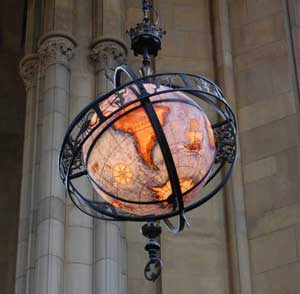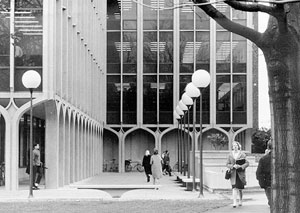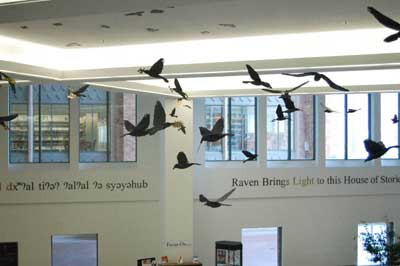Graduate Reading Room U University of Washington
Suzzallo Library
The University of Washington was founded in 1861, less than ten years after the creation of the Washington Territory and earlier the settler population had exceeded 350. The University moved to its current campus location in 1895. Later 1909 the library was located in a building synthetic for the Alaska-Yukon-Pacific Exposition and soon outgrew the infinite.
In 1915, when Henry Suzzallo was appointed President of the University, a new library edifice became one of his top priorities. When planning began in 1922, Suzzallo envisioned a library that was to be "the soul of the academy."
An case of the Collegiate Gothic style, the library was designed by Carl F. Gould, Sr. and Charles H. Bebb, Seattle architects of national stature who has too created the 1915 campus plan. Basis was cleaved for the new library in 1923.
Soon after, President Suzzallo found himself involved in political rivalries and controversies that resulted in his dismissal from the Academy. The library, the crown jewel of his administration, was named for him following his death in 1933.

Suzzallo Library, named for Henry Suzzallo, the fifteenth president of the University, opened in 1926.
Facade

The outside of Suzzallo Library is composed of sandstone, precast stone, terra-cotta and brick, with a slate roof. The windows are of leaded and stained glass.
Eighteen terra-cotta figures in niches atop buttresses were selected by the UW faculty in 1923 to symbolize contributions to learning and culture. Allan Clark, a young sculptor from Tacoma, was commissioned to create the figures, which include, from left to right, Moses, Louis Pasteur, Dante, Shakespeare, Plato, Benjamin Franklin, Justinian, Sir Isaac Newton, Leonardo da Vinci, Galileo, Goethe, Herodotus, Adam Smith, Homer, Gutenberg, Beethoven, Darwin and Grotius.
Just to a higher place the main doors stand figures of cast stone depicting "Mastery," "Inspiration" and "Thought," also sculpted past Clark.
A series of shields depicts coats of artillery from universities effectually the world, including Toronto, Louvain, Virginia, California, Yale, Heidelberg, Bologna, Oxford, Paris, Harvard, Stanford, Michigan, Uppsala and Salamanca.
Grand Staircase
The Grand Staircase leads from the beginning to the third floors (The 1963 addition to Suzzallo added a flooring between the first and 2nd floors of the original edifice). Note the travertine treads worn by decades of students climbing the stairs.

Grand Stair Hall
At the acme of the Grand Staircase is the Grand Stair Hall. In 1926, this area was a rotunda surrounded by stained glass windows.
The southeast wing was constructed in 1935. The original blueprint called for an octagonal carillon tower over 300 anxiety high. Although it was never built, the shape is reflected in motif of the limestone floor.
The vaulted ceiling reveals a "batwing" – a organization of steel reinforcing beams resembling the fly structure of a bat – one of the more visible features of a seismic renovation that Suzzallo underwent betwixt 2000 and 2002, at a cost of $47 one thousand thousand.
Kingdom of bhutan Book

The K Stair Hall also houses 1 of the world's biggest books, a series of photographs of Bhutan by Michael Hawley. Protected past light-safe glass, the book's pages are turned virtually one time a month by Library staff.
Reading Room

The Suzzallo Reading Room measures 65 anxiety high, 52 anxiety wide, and 250 anxiety long.
The Suzzallo Reading Room features a vaulted ceiling with vibrantly colored and gilded details. A 1927 article in The Pacific Builder and Engineer stated that "This room has been pronounced past experts to be the about beautiful on the continent and is ranked amongst the about beautiful in the globe."
Oak bookcases along the walls are topped with mitt-carved friezes representing native plants of Washington State, including salal, Douglas fir, scrub oak, grape, dogwood, mountain ash, rhododendron, pear, trillium, salmon berry, wild rose, apple, marigold, cantaloupe, tulip and crimson.
Leaded-glass windows incorporate medallions representing 28 Renaissance watermarks from a book purchased by the University Library in 1923, Les Filigranes: Dictionnaire Historique des Marques du Papier, a four-volume ready past C.M. Briquet.
Globes
At each end of the reading room, hangs a hand-painted world globe, each of which bear names of explorers. In the south alcove, Leif Ericson, Marco Polo, Columbus, Amerigo Vespucci, Magellan, Henry Hudson, Vasco da Gama and Juan Rodriguez Cabrillo. In the north apse, Ponce de Léon, Hernando Cortez, Capt. John Smith, Sir Walter Raleigh, Fray Junípero Serra, Vasco Núñez de Balboa, Francisco Pizarro, John Cabot, Jacques Cartier and Fernando de Soto.

Suzzallo 1961-63 Addition
As you go out the Reading Room through the M Stair Hall, a transition in the flooring from sandstone to linoleum marks the 1963-1961 addition of 125,000 foursquare feet. Architects Bindon and Wright departed radically from Bebb and Gould's original plans for the library with modernistic architecture designed to harmonize with the gothic elements in the original building, too equally with those in surrounding campus buildings.

Allen Library
The Allen Library was completed in 1990, proving shelving for over a one thousand thousand volumes equally well every bit ultraviolet filtering for lights and windows.
In 1988, the Washington State Legislature approved funding for the structure of the Allen library, designed past Edward Larrabee Barnes Assembly of New York. The brick and terra-cotta facade by Daniel Casey ties the building to existing campus architectural styles.
The library was named for Kenneth S. Allen, Associate Director of Libraries from 1960 to 1982, in recognition of his years of service to the Libraries, and in appreciation of a generous gift from his son, Paul Thousand. Allen, co-founder of Microsoft.
Art Installation

In 1994, artists Carl T. Chew, Mare Blocker, J. T. Stewart, and Ron Hilbert installed their collaborative artwork, Raven Brings Light to This Business firm of Stories in the Allen Library as office of the Washington State Art in Public Places Program.
In Pacific Northwest Native American lore, the raven is the beingness who went eastward to bring the light to the West. 40 ravens and crows are suspended from the ceiling and behave symbols from cultures around the world. The title is displayed to a higher place the windows in the Lushootseed and English languages. Additional artworks in the immediate area include poems, a paw-made book, and a study table.
Tomistoma Machikanense

In the south wing of the Allen Library is a cast of a 28 foot fossil crocodile, Tomistoma machikanense, from the tardily Pleistocene, thanks to a special organisation with the Burke Museum at the University of Washington.
Source: https://www.lib.washington.edu/suzzallo/visit/about
0 Response to "Graduate Reading Room U University of Washington"
Post a Comment